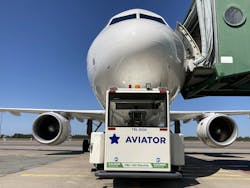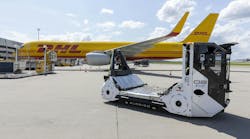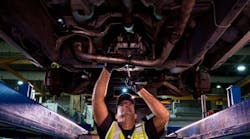Aviator Airport Alliance is setting the standard for adoption of electric ground support equipment (eGSE) by balancing the process while ensuring recycling of legacy assets. As part of Aviator’s commitment to become carbon neutral in its operations by 2026, the full-range provider of aviation services has already cut CO2 emissions by 50 percent per departure since 2019. This success is due largely to well above half of Aviator’s GSE fleet being electrically powered.
The adoption of modern technologies is key to Aviator’s sustainability goals, but the process has created a unique challenge for unsung professionals in Aviator’s network of GSE maintenance shops. Just as the aircraft they serve require specialized maintenance needs, so too does the GSE used for airline operations.
While electric vehicle integration is an ongoing process at Aviator, there is an diverse age demographic among ground service devices. At Copenhagen Airport (CPH), the oldest equipment, a belt loader for loading cargo and passenger bags, has been in operation for a very long time. The newest machines were delivered this year. However, newer equipment requires new expertise for maintenance. Nicki Komi, GSE manager at Aviator, says that the company’s staff were provided additional training on the differences between newer and older equipment maintenance.
“We book a training from the GSE supplier to make sure that the workshop personnel have the best possible knowledge from the manufacturer to handle the GSE in all types of challenges,” Komi says. “We have to be more aware of the electrical driveline and battery pack, and workshop employees have to take a special course to be allowed near a high-voltage system that could potentially kill a person if caution and safety is not in focus when servicing these types of equipment.”
Apart from the training Aviator employees receive for new GSE, Komi adds that the newer electric equipment has proven advantages in terms of maintenance. The machinery is easier to service when it comes to the engine drive, as there are no combustion engines with filters, pumps, drivebelts, exhaust systems and fuel lines.
The adoption of new electric equipment creates a surplus of older GSE that is no longer needed. Rather than having items sit derelict, Aviator has elected to recycle its retired GSE. Retirement is all about protection of our environment, so the process begins with an environmental treatment. When GSE is being recycled, the item will be drained of all liquids, and go through a chemical care process before being parted out and scrapped, according to Komi. The components that can be reused from the GSE going through the recycling process are saved. What is left after chemical treatment and parting out is a steel body, which is given to local recycle stations to be reused by the steel industry.
Aviator has recycled more than 10 units of GSE so far at CPH, including older cars, crew buses, beltloaders, highloaders, cargo trucks, water and toilet service trucks, and pushback tugs, Komi says.








